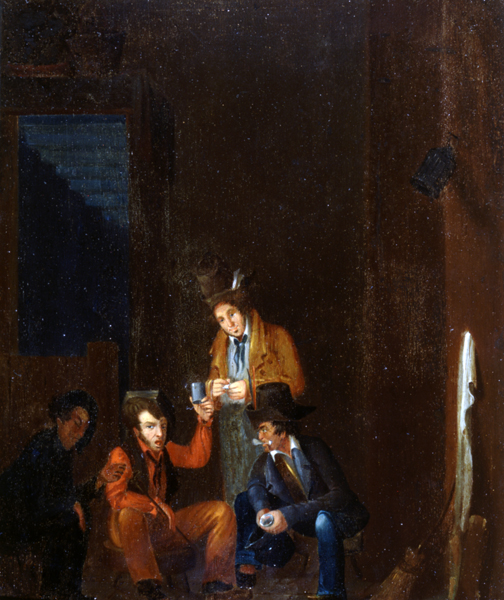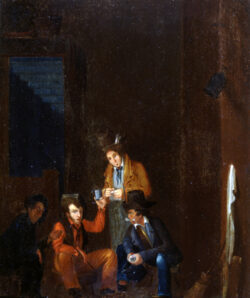Jean and Pierre Laffite
Two French brothers notorious for smuggling and slave trading also participated in the Battle of New Orleans.
This entry is 7th Grade level View Full Entry

Louisiana State Museum
A painting by Ezra Ames, long mistakenly believed to represent Jean Laffite and still evocative of his persona, ca. 1830.
Of all the storied characters in Louisiana’s early history, two brothers—Jean and Pierre Laffite—rank among the most notorious and noteworthy. As with almost all pirates and privateers, the lives of the Laffite brothers spawned numerous tales of secret gold and hidden treasure. However, as is the case with virtually all such treasure tales, they are works of imagination. Remarkably little is known of the Laffites’ lives, and much assumed common knowledge is myth.
What was Pierre and Jean Laffite’s early life like, and how did they end up in Louisiana?
Pierre and Jean Laffite (sometimes spelled “Lafitte” or “Laffitte”) were born in the village of Pauillac, France. Their father was the merchant Pierre Laffite, but they appear to have had different mothers. Their father died in 1796, by which time Pierre may already have visited the French Caribbean colony of St. Domingue, where one of his brothers was already living. It is clear that Pierre left France for Louisiana by May 1802.
By March 1803 Pierre had reached New Orleans. During the next ten years, Pierre lived in New Orleans, Baton Rouge, and Pensacola. He was a merchant, but it is almost certain that neither he nor his brother Jean was ever a blacksmith, as popular legend holds. In 1804 Pierre began working in the slave trade.
Meanwhile Jean’s activities are virtually unknown from the time of his birth until 1809, when he was in New Orleans. He probably spent some years at sea, possibly as a privateer. In November 1809 one New Orleanian referred to him as “the notorious Captain Laffitte,” suggesting that he had achieved a level of notoriety, probably stemming from his activities in the slave trade. He reportedly imported enslaved people who had been captured by illegal Spanish privateers, smuggling them into Louisiana through Barataria Bay and other isolated spots on the coast. Rather than operating his own vessel, Jean may have been working as a middleman between the privateers and his brother, Pierre, who marketed the enslaved men, women, and children in and around New Orleans. All these activities violated the 1808 law abolishing the foreign slave trade.
The Laffite brothers made influential connections in New Orleans and successfully operated as smugglers for years, despite various efforts to stop them. Though they weren’t the only smugglers in the region, they evolved into some of the most successful, especially after President Thomas Jefferson’s 1807 embargo stopped the flow of imported goods from Europe. When the War of 1812 broke out, the brothers’ business flourished as the British blockade further tightened the flow of imports.
What role did the Laffite brothers play in the Battle of New Orleans?
In August 1814 British officers intending to attack New Orleans during the War of 1812 attempted to engage the Laffite brothers’ assistance, but Jean declined. Despite this show of loyalty to the American cause, in September US naval forces attacked and destroyed the Laffites’ base in Barataria Bay, seizing all their ships. The brothers fled, but Jean soon traded their services to the authorities in return for pardons. During the Battle of New Orleans in 1815, Jean seems to have been in the bayous guarding a possible backdoor approach to the city, while Pierre acted as a guide on the American army’s left flank and saw some limited fighting. It was later claimed that the Laffites provided much-needed cannons for the American army, but in fact, virtually all their artillery was lost with their base in Barataria. The brothers did provide several thousand musket flints to Andrew Jackson’s army, and some of their followers did act as artillerymen in the battle, but their role wasn’t as important as the legend claims.
What did the Laffite brothers do after the War of 1812?
The government honored its promise to pardon the Laffites, but the brothers returned almost immediately to smuggling. They moved to Galveston Island in Spanish Texas, where they became deeply involved with the New Orleans Association—a group of businessmen interested in seizing Mexico and Central and South America for themselves or the United States. On Galveston Island, the brothers acted as paid spies for Spain. They also continued their smuggling activities, receiving goods from privateers and selling them to Louisiana planters who came to buy enslaved people and other merchandise.
By May 1820 the United States had had enough of the Laffites’ illegal operations and persuaded the brothers to close down on threat of being forced out by naval forces. Jean set off with three ships, reportedly to become a privateer for a warlord in Colombia, Venezuela, or Buenos Aires. Meanwhile, Pierre closed the brothers’ affairs in New Orleans and went to Charleston, South Carolina, to buy a ship and enlist a crew for privateering. In March 1821 he established a base of operations at Isla de Mujeres off the Yucatán coast in present-day Mexico, but Spanish authorities soon tried to drive him out. On October 30 these authorities attacked and captured Pierre and a few others. Though he quickly escaped Pierre may have been wounded in the skirmish or ill at the time of the attack, since he almost immediately fell into a severe fever. Pierre died on or about November 9, 1821.
After his brief career as a pirate, Jean became a privateer and took command of the General Santander. On February 4, 1823, he ran into two small Spanish warships that he couldn’t outrun. In the fight that erupted, he fell mortally wounded and was buried at sea the next day.
What legacy did the Laffite brothers leave behind?
Once the Laffite brothers were gone, there was little left by which to remember them, except stories that quickly grew into legend. Pirates and privateers were by nature reckless; they didn’t hide or bury money or treasure goods. When they got money, they spent it and then went after more. Virtually all of them died poor. The Laffites’ impact on their times was minimal. The Battle of New Orleans would have been won without them. Galveston Island would have been settled without them, and it was soon repopulated after they left. In fact, their chief impact on Louisiana’s history was as folk heroes, their legend quickly overwhelming the reality of their lives. In the case of the younger brother, the legend endures among institutional namesakes such as the village of Jean Lafitte and the unincorporated Lafitte community in Jefferson Parish, as well as Jean Lafitte National Historical Park and Preserve, which encompasses six sites across a two-hundred-mile swath of South Louisiana.
